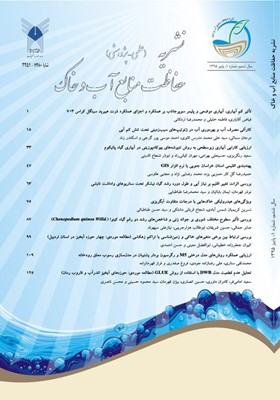بررسی ارتباط بین برخی متغیرهای خاکی و زمین شناسی با تراکم زهکشی (مطالعه موردی: چهار حوزه آبخیز در استان اردبیل)
محورهای موضوعی : مدیریت آب در مزرعه با هدف بهبود شاخص های مدیریتی آبیاریکیوان جعفرزاده خطیبانی 1 , ابوالفضل معینی 2 * , حسن احمدی 3
1 - دانش آموخته کارشناسی ارشد؛ گروه آبخیزداری، دانشکده کشاورزی و منابع طبیعی؛ دانشگاه آزاد اسلامی، واحد علوم و تحقیقات؛ تهران؛ ایران
2 - استادیار، گروه آبخیزداری؛ دانشکده کشاورزی و منابع طبیعی؛ دانشگاه آزاد اسلامی؛ واحد علوم و تحقیقات؛ تهران؛ ایران
3 - استاد، گروه آبخیزداری؛ دانشکده کشاورزی و منابع طبیعی؛ دانشگاه آزاد اسلامی؛ واحد علوم و تحقیقات؛ تهران؛ ایران
کلید واژه: سیلت, ضریب فرسایشپذیری, سازند, کربن آلی,
چکیده مقاله :
فرسایش خاک یک مشکل جدی زیست محیطی شناخته شده است. تراکم زهکشی از مهم ترین پارامترهای ژئومورفولوژیکی حوزه آبخیز است که از آن به عنوان شاخصی برای بیان وضعیت آبراهههای حوضه، بارندگی، رواناب، ظرفیت نفوذپذیری، تکامل توپوگرافی و فرسایش حوضه استفاده میشود. با دانستن رابطه دقیق خصوصیات حوضه با تراکم زهکشی، می توان با در اختیار داشتن تراکم زهکشی سایر خصوصیات حوضه را پیش بینی نمود. هدف از این تحقیق بررسی تأثیر خصوصیات خاک و سازند روی تراکم زهکشی در بخشی از استان اردبیل بود. بدین منظور اطلاعات پایه، گردآوری و محدوده همه حوضهها روی نقشه توپوگرافی مشخص و نقشه اجزای واحد اراضی و زمین شناسی تهیه و در هر اجزاء، نقاطی جهت حفر پروفیل تعیین شد. تراکم زهکشی از نرمافزار Arc GIS محاسبه و در نهایت رابطه بین خصوصیات خاک و سازند با تراکم زهکشی از طریق ترسیم نمودار تعیین و میزان همبستگی این دو فاکتور با تراکم زهکشی با نرمافزارSPSS بررسی شد. نتایج نشان داد که ارتباط بین تراکم زهکشی و خصوصیات خاک در سازندهای زمینشناسی و اجزای واحد اراضی در سطح اطمینان 95 درصد معنیدار میباشد. بنابراین تراکم شبکه زهکشی متأثر از جنس سازندها، میزان شیب و برخی خصوصیات خاک نظیر آهک، درصد سیلت، کربن آلی و ضریب فرسایش پذیری هستند. همچنین بیش ترین تراکم زهکشی مربوط به سازندهای دوره کواترنر، بدون پوشش گیاهی مناسب و سازند Ngm و کم ترین تراکم زهکشی مربوط به توف و سنگ آهک بود.
Soil erosion has been known as a serious environmental problem. Drainage density is one of the most important geomorphological parameter that is used as an index for stream situation, rainfall, runoff, infiltration capacity, topography evolution and erosion. With knowledge about the relationship between characteristic basin with drainage density, we can predict the other properties of basin. The aim of this study was survey of relationship between soil and geology characteristics with drainage density. First, basic information was collected and watersheds boundary was found on topography map. Land component and geology map was prepared and in each land component was determined locations for profile. After field checking at determined location dug profiles and determine physicochemical parameters of soils. Drainage density was calculated using ARC GIS software. Finally using Excel 2013 through charting, the relation between soil characteristics with drainage density was determined and correlation of these factors were analyzed using SPSS software. Results showed that the relationship between soil properties and drainage density in formation and land component is significant at 95 percent level. Also results indicated that drainage density is affected by lithology of formation, slope, and some properties of soil such as TNV, silt, organic carbon and coefficient of erosibility. The maximum of drainage density belonged to quaternary formation without proper plant cover and NGM formation ad minimum of drainage density belonged to TUF and lime formation. Therefore, to some extent, with using of drainage density we can predict soil and geology properties.
احمدی، ح.، کلارستاقی، ع. و مشهدی، ن. 1386. بررسی فرسایش در رخسارههای ژئومورفولوژی و ارتباط آن با تراکم زهکشی در حوزه آبخیز سرولایت. نشریه مرتع و آبخیزداری دانشگاه تهران (مجله منابع طبیعی ایران). شماره 4. 1097-1085.
بیاتیخطیبی، م. 1383. نقش تراکم زهکشی و اختلاف ارتفاع بر وقوع لغزشهای درهای در کوهستانهای نیمه خشک دامنههای شمال غربی سبلان. ویژهنامه جغرافیا. شماره 2. 82 – 59.
رضایی مقدم، م. ح. و احمدی، م. 1385. تحلیل ژئومورفولوژی کمّی الگوی زهکشی شبکه آبراههای به کمک زاویه برخورد آنها در زیرحوضه سریاس.، استان کرمانشاه. تحقیقات جغرافیایی. ش 81.
نیکرو، ل. و ثابتاقلیدی، م. 1383. بررسی روند فرسایش آبی با توجه به سازند زمینشناسی و خاک (مطالعه موردی حوضه رودبال داراب). دومین کنفرانس ملی دانشجویی منابع آب و خاک. دانشکده کشاورزی دانشگاه شیراز.
Altaf, F. Meraj, G and Romshoo, Sh. A. 2013. Morphometric Analysis to Infer Hydrological Behaviour of Lidder Watershed, Western Himalaya, India. Geography Journal.
Bayer Altın, T. and Necati Altın, B. 2011a. Development and morphometry of drainage network in volcanic terrain, Central Anatolia, Turkey. Geomorphology. 485-503.
Bayer Altin, T. and Necati Altin, B. 2011b. Drainage morphometry and its influence on landforms in volcanic terrain, Central Anatolia, Turkey. Procedia Social and Behavioral Sciences. 19, 732–740.
Germanoski, D. Hardy, S. and Wilson, J. 2012. Comparison of Drainage Density in Carbonate VS Shale/Slate, eastern pennsylania. Spring specialty conferece New Orleans, Louisiana.
Poyraz, Murat. Taskın, Sevil. Keles, Kemal. 2011. Morphometric approach to geomorphologic characteristics of Zeytinli Stream basin. Procedia Social and Behavioral Sciences 19. 322–330.
Prakasam, C. and Biswas, B. 2012. Evaluation of Geomorphic resources Using GIS Tecnology: A Case Study of selected villages in ausgram block, Burdwan district, West Bengal, INDIA. International Journal of Geology, Earth and Environmental Sciences.2(2), 193-205.
Ribolini A, Spagnolo M. 2008. Drainage network geometry versus tectonics in the Argentera Massif (French–Italian Alps). Geomorphology. 253–266

